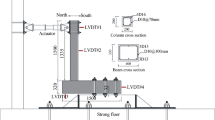Abstract
The bond mechanism between Glass Fiber Reinforced Polymer (GFRP) bars and concrete is investigated through experimental testing and analytical modeling. This bond depends on several parameters such as temperature. The present paper studies the thermal effect, under high temperature up to 80°C, on bond behaviour at the interface GFRP bars/concrete through pullout-testing. These tests are conducted on specimens after 24 h of exposure at various temperatures. The thermal effect on an average short-term bond strengths and the pullout-load versus end-slip behaviours are compared to untreated specimens (20°C). Some pullout-tests on steel bars/concrete are also performed for the comparison. Experimental results show no significant change in the average bond strength for specimens subjected to temperatures up to +60°C. On the other hand at 80°C, there is a decrease of bond strength of about 22 and 28% for the 8 mm and the 16 mm diameter rods, respectively. An analytical model of the bond stress-slip response of a GFRP/concrete bar has been proposed. The results show good accuracy between the model and the experimental results.












Similar content being viewed by others
References
Katz A, Berman N, Bank LC (1999) Effect of high temperature on bond strength of FRP rebars. ASCE J Comp Const 3(2):73–81
Kumahara S, Masuda Y, Tanano Y (1993) Tensile strength of continuous fiber under high temperature. In: Nanni A, Dohan CW (eds) International symposium on fiber-reinforced plastic reinforcement for concrete structures. American Concrete Institute (ACI) SP-138, pp 731–742
Wang YC, Kodur V (2005) Variation of strength and stiffness of fiber reinforced polymer reinforcing bars with temperature. Cem Concr Compos 27(9–10):864–874
Wang YC, Wong PMH, Kodur V (2007) An experimental study of the mechanical properties of fibre reinforced polymer (FRP) and steel reinforcing bars at elevated temperatures. Compos Struct 80(1):131–140
Ehsani MR, Saadatmanesh H, Tao S (1997) Bond behavior of deformed GFRP rebars. J Compos Mater 31(14):1413–1430
Masmoudi R, Alvarez A (2007) Pullout bond behaviour of FRP bars embedded in concrete under different temperatures. Actes du colloque SOMAPRO 2007, Hammamet, Tunisia, pp 369–379
Dutta PK (1988) Structural fiber composite materials for cold regions. J Cold Reg Eng 2(3):124–132
Verghese K, Haramis J, Patel S, Senne J, Case S, Lesko J (2001) Enviro-mechanical durability of polymer composites. In: Monteiro PJM, Chong KP, Larsen-Basse J, Komvopoulos K (eds) Long term durability of structural materials. Elsevier Science Ltd, Amsterdam, pp 121–131
Katz A, Berman N, Bank L (1998) Effect of cyclic loading and elevated temperature on the bond properties of FRP rebars. In: Benmokrane B, Rahman H (eds) Proceedings of the 1st international conference on the durability of composites for construction CDCC98, Sherbrooke, Canada, pp 403–413
Katz A, Berman N (2000) Modelling the effect of high temperature on the bond of FRP rebars to concrete. Cem Concr Compos 22:433–443
Galati N, Nanni A, Dharani LR, Focacci F, Aiello MA (2006) Thermal effects on bond between FRP rebars and concrete. J Compos A 37:30–36
Zaidi A, Masmoudi R (2007) Numerical analysis of the transverse thermal behavior of FRP bars embedded in concrete. CDCC-07, QC, Canada, pp 303–310
Cosenza E, Manfredi G, Realfonzo R (1997) Behaviour and modelling of bond of FRP rebars to concrete. J Compos Constr 1(2):40–51
Alvarez A, Zaidi A, Mamsoudi R (2007) Bond slip behaviour of FRP bars under low and high temperature—experimental and theoretical studies. CDCC-2007, pp 523–530
Schock Bauteil GmbH Combar (2006) Design guideline for concrete structures reinforced with glass fiber reinforced polymer following the requirements of DIN 1045-1 and EC2 issued Germany, 26 pp
Aboutaha R (2004) Recommended design for the GFRP Rebar Combar®. Syracuse University, Department of Civil and Environmental Engineering technical report, sponsored by Schok Bauteile GmbH, USA, 11 pp
ACI 318-05 (2005) Building code requirements for structural concrete (318-05) band commentary (318R-05). American Concrete Institute (ACI), USA
ACI Committee 440 (2004) Guide test methods for fiber-reinforced polymers (FRPs) for reinforcing or strengthening concrete (ACI 440.3R-04). American Concrete Institute, Farmington Hills, 40 pp
Boyle HC, Karbhari VM (1994) Investigation of bond behaviour between glass fiber composite reinforcements and concrete. Polym Plast Technol Eng 33(6):733–753
Nanni A, AlZaharani MM, Al-Dulaijan SU, Bakis CE, Boothby TE (1995) Bond of FRP reinforcement to concrete. Experimental results. In: Taerwe L (ed) Proceedings of the 2nd international symposium on non-metallic (FRP) reinforcement for concrete structures. E and FN Spon, London, pp 135–145
Tighiouart B, Benmokrane B, Gao D (1998) Investigation of bond in concrete member with fibre reinforced polymer (FRP) bars. Constr Build Mater 12(8):453–462
Eligehausen R, Bertero V, Popov EP (1982) Analytical model for concrete anchorages of reinforcing bars under generalized excitations. Report no. UCB/ERC 82/23. EERC, University of California, Berkeley
Diab H, Wu Z (2006) Constitutive model for time-dependent bonding and debonding along FRP-concrete interface. In: 3rd international conference on FRP composites in civil engineering (CICE 2006), Miami, FL, USA
Acknowledgments
The authors wish to acknowledge the “Schock Bauteil GmbH Combar®” and “Sika Tunisienne” for their help in providing the necessary materials. They also thank Dr. Atef Daoued for his help in the work.
Author information
Authors and Affiliations
Corresponding author
Rights and permissions
About this article
Cite this article
Masmoudi, A., Masmoudi, R. & Ben Ouezdou, M. Thermal effects on GFRP rebars: experimental study and analytical analysis. Mater Struct 43, 775–788 (2010). https://doi.org/10.1617/s11527-009-9547-2
Received:
Accepted:
Published:
Issue Date:
DOI: https://doi.org/10.1617/s11527-009-9547-2




